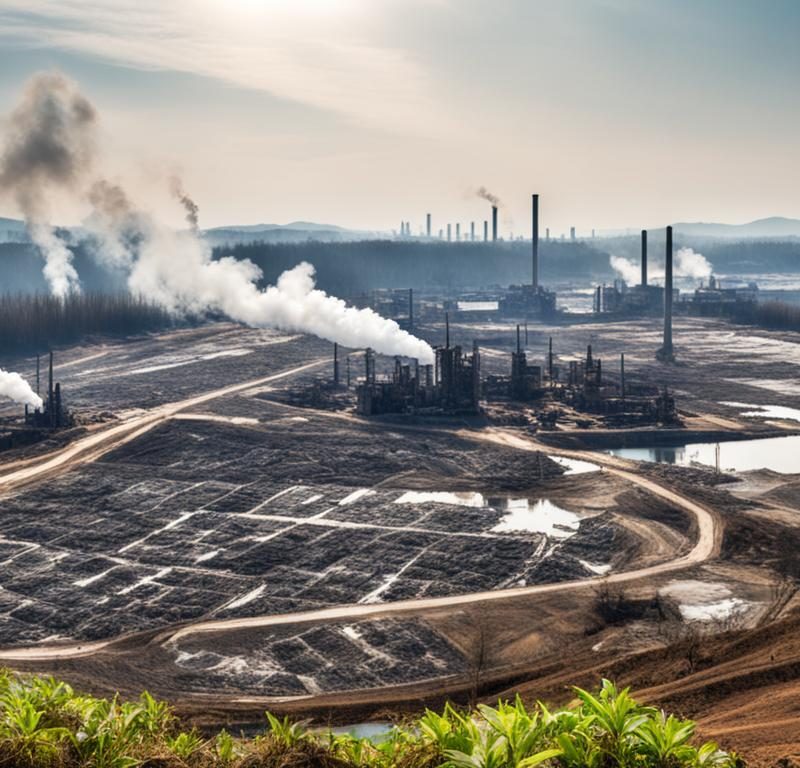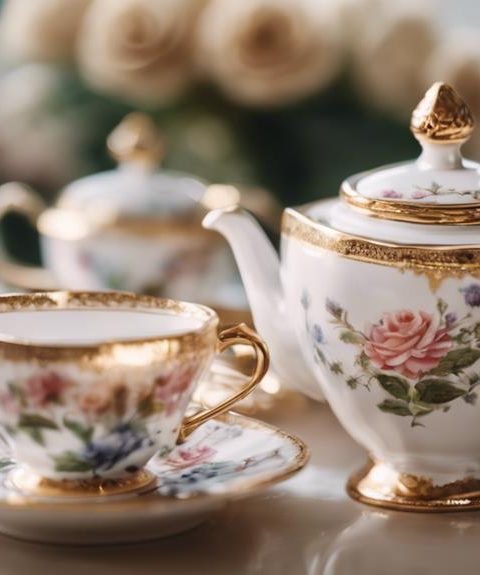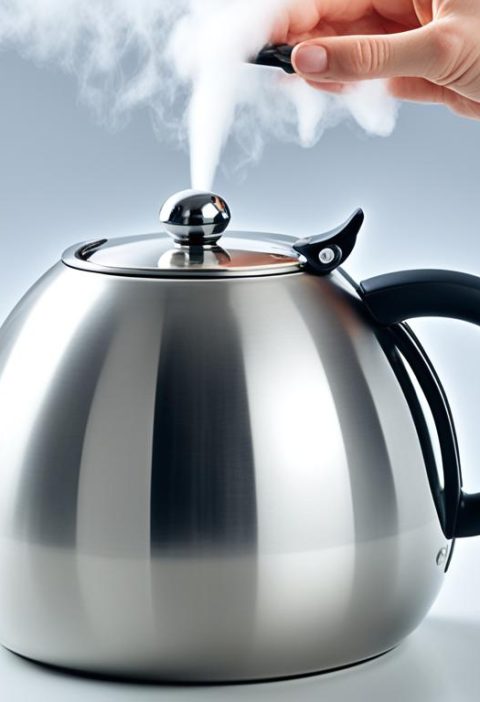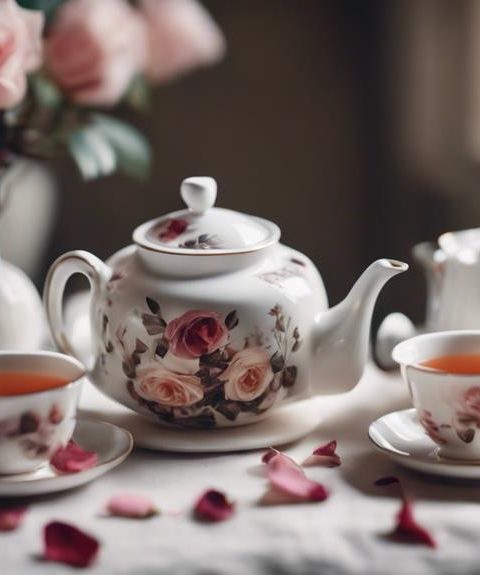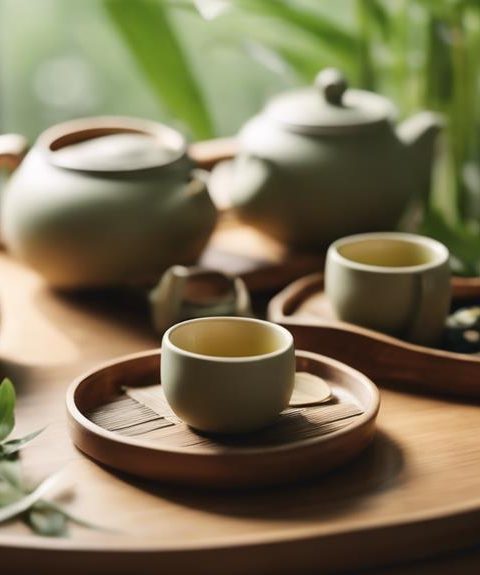Tea is loved around the globe and comes with a history that spans thousands of years. It is the second most popular drink, right after water. China, India, and Kenya make the most tea in the world. Tea has antioxidants that are good for you. Yet, making tea the wrong way can hurt the earth. It uses a lot of water and energy. There is also a problem with pesticides, carbon, and cutting down trees. People’s rights can be ignored too. We can fix these issues by picking organic and Fair Trade tea. We should also use tea sets that do not hurt the planet and brew our tea wisely. This can make tea-drinking kinder to the earth and the people who grow it.
What is Sustainable Tea Consumption?
Sustainable tea drinking means choosing teas and ways of making tea. This helps not to harm the environment or people. It’s about picking teapots and brewing in a way that is gentle on the planet.
How can I engage in eco-friendly tea drinking?
Start by picking teas grown in ways that do not hurt the earth. This means choosing organic teas that are not treated with bad chemicals. Also, look for Fair Trade teas. This makes sure the people who grow tea are paid well and work in good conditions.
What are the benefits of choosing organic tea?
Picking organic tea is good for the planet and for you. Organic teas are made without harmful chemicals. This makes them a healthful choice. They are grown in ways that keep the earth’s health in mind.
How can I contribute to ethical tea production?
You can help ethical tea production by buying from brands that care about nature and people. Look for teas that come from companies that support fair trade, care about sourcing tea the right way, and package tea in eco-friendly ways. This way, you support a healthier planet and people who farm tea.
What are some eco-friendly tea brewing methods?
To brew tea in an eco-friendly way, use teapots and tools that are good for the earth. Choose teapots made from things like clay. These not only look nice but are also less harmful to the planet. Also, learn to brew tea in ways that let you get more cups from the same tea leaves. This cuts down on waste.
Key Takeaways:
- Sustainable tea drinking helps the planet and people.
- Choosing organic and Fair Trade teas is good for ethical tea making.
- Using eco-friendly teapots and methods lessens harm to the environment.
- Picking local teas and green packaging cuts down on pollution.
- By choosing sustainable tea brands, you support a cleaner tea industry.
The Environmental Impact of Non-Sustainable Tea Production
Tea farming can harm the planet in many ways, especially when not done sustainably. It uses a lot of water and energy. About 4,000 liters of water are needed for just one kilogram of tea. Such heavy use of water strains our water resources. It makes problems like water scarcity even worse.
The use of pesticides and fertilizers in tea farming is a big issue too. These chemicals can pollute the soil and water. They can flow into rivers and lakes, causing harm to fish and people. Also, they add to the greenhouse gases that cause climate change.
Then, there’s the tea’s journey from the farm to your cup. Shipping tea around the world creates a lot of carbon emissions. This adds to climate change. Also, the materials used to pack tea, like plastic and single-use bags, add to our plastic problem.
But perhaps the biggest problem is the cutting down of forests. Trees are cleared to grow more tea. This takes away the homes of many animals and plants. It also releases carbon dioxide, which makes climate change worse.
The people involved in tea production often suffer too. There are reports of child labor and bad working conditions. Some workers face long hours, low pay, and dangerous jobs.
The Environmental Impact of Tea Production: FAQs
1. How does tea production contribute to high water and energy usage?
Tea farming uses a lot of water and energy. It takes up to 4,000 liters of water to make just 1 kilogram of tea. This demand harms our water supply and increases water scarcity. The process of making tea also needs a lot of energy.
2. What are the environmental consequences of pesticide and fertilizer pollution in tea production?
Pesticides and fertilizers harm the soil and water. They can get into rivers and lakes and hurt the life there. They also add to the gases causing climate change.
3. How does transportation and packaging of tea products impact the environment?
Shipping tea worldwide releases a lot of carbon emissions. This worsens climate change. The materials used to pack tea, like plastic, also hurt the environment.
4. What are the consequences of deforestation for tea plantations?
Taking down forests for tea farms takes away habitats and lowers biodiversity. It messes up ecosystems and adds to climate change by releasing carbon dioxide.
5. How is the tea industry associated with human rights abuses?
The tea business is connected to bad practices like child labor and unsafe working conditions. Some workers have to do tough jobs for little pay.
| Environmental Impact | Key Points |
|---|---|
| High water and energy usage | Tea production needs lots of water and energy. This makes water scarce and uses a lot of energy. |
| Pesticide and fertilizer pollution | These chemicals harm the soil and water. They hurt ecosystems and health. |
| Carbon emissions | Moving tea around and its packaging make carbon emissions. This adds to climate change. |
| Deforestation | Cutting down forests for tea hurts habitats, lowers biodiversity, and increases carbon dioxide in the air. |
| Human rights abuses | The tea industry can have child labor, bad working conditions, and low pay. |
Choosing Sustainable Tea Products
Choosing the right tea products are key in living by your values. Choosing sustainable tea helps the environment and encourages fair tea making. Here are ways to pick the right tea:
1. Opt for Organic Tea
Organic teas are grown naturally, without harmful chemicals. Picking organic means you help the earth and back better farming methods.
2. Look for Fair Trade Certification
A Fair Trade label means tea workers earn fair wages and work in safe places. Buying Fair Trade teas backs ethics in the tea business.
3. Consider Eco-Friendly Packaging
Choose teas packed in recyclable or compostable materials to cut waste. Supporting brands with green packaging shows your care for the planet.
4. Buy Loose-Leaf Tea in Bulk
Getting loose-leaf tea in bulk lessens waste from packaging. You can use your own containers or bags, avoiding one-time use waste.
5. Choose Locally Sourced Tea
Local teas cut down on fuel use from transporting teas long distances. Buy from brands getting tea from close by to help the local economy and the planet.
| Sustainable Tea Products | Benefits |
|---|---|
| Organic Tea | Reduced environmental impact |
| Fair Trade Certified Tea | Supports fair wages and safe working conditions |
| Eco-Friendly Packaging | Reduces waste and carbon footprint |
| Loose-Leaf Tea | Minimizes packaging waste |
| Locally Sourced Tea | Reduces carbon footprint |
Eco-Friendly Tea Sets and Brewing Methods
Make your tea time green by using eco-friendly tea sets and methods. For a unique experience, try brewing in a Turkish or East Asian teapot.
What is an eco-friendly tea set?
An eco-friendly tea set is made from materials that don’t harm the planet. It’s designed to be kind to the earth by not using materials that stick around forever. This choice supports sustainable ways of living.
How can eco-friendly tea sets benefit the environment?
They lessen waste and the harm tea making can cause. These sets are often crafted from things like bamboo or glass. They’re much better for the environment than plastic or things you throw away after one use. Using them means you’re helping to keep the planet healthy.
What is a Turkish teapot?
The Turkish teapot, or caydanlik, is special for brewing tea in Turkey. It has two kettles stacked on top of each other. The bottom one boils the water, and the top one steeps the tea. This makes a strong tea that can stay warm all day.
How is the Turkish teapot eco-friendly?
This teapot saves energy with its smart design. Because it has two kettles, it keeps the heat inside. That means you can make tea once and enjoy it for a long time without using more energy. Using it is a greener way to enjoy your daily tea.
What is an East Asian teapot?
The East Asian teapot, like the Tetsubin, is from countries such as Japan. It’s mostly made of cast iron with a special coating inside. This teapot also has a filter for loose tea leaves.
Are East Asian teapots sustainable?
Yes, these teapots are good for the planet. Cast iron is very sturdy and lasts a long time. The built-in filter means you don’t need to buy and throw away tea bags. Choosing this teapot is a lovely way to brew your tea while caring for the environment.
| Teapot Type | Key Features | Benefits |
|---|---|---|
| Turkish Teapot (Caydanlik) | Double-kettle design Concentrated tea preparation Ability to keep tea warm |
Efficient energy usage Multiple servings from a single brew Convenient for all-day tea enjoyment |
| East Asian Teapot (Tetsubin) | Cast iron construction Built-in tea strainer |
Durable and long-lasting Eliminates the need for disposable filters |
Go green with tea sets like the Turkish and East Asian teapots. These teapots offer special ways to brew tea. They also help you care for the earth with eco-conscious designs.
Tips for Sustainable Tea Brewing
For sustainable tea brewing, focus on water temperature, steeping time, and reusing leaves. This makes your tea taste good and is good for the planet. It’s a way to enjoy tea while keeping waste low.
What is the optimal water temperature for brewing tea sustainably?
The right water temperature differs by tea type. Some teas, like green, should brew at 175°F for 1-2 minutes for their best taste. Oolongs, however, need 195°F and 3-5 minutes to bring out their full flavor. Knowing the best temps and times is key to tasty tea.
How long should you steep tea sustainably?
Steeping time matters a lot. It decides how strong your tea’s flavor will be. Shorter times, around 1-2 minutes, are good for green teas. Blacks prefer longer, about 3-5 minutes. But, you can adjust as you like to get it just right.
Can you reuse tea leaves for multiple brews?
Yes, you can. Reusing tea leaves is great for a second cup. Some teas, like Oolong, are great for this. They might taste different but still good each time you brew. Experiment to see what you like best.
Can you compost used tea leaves?
Yes, tea leaves are great for compost. They add nutrients to the soil. Just remember to not compost any tea bags or teas with non-natural parts. This helps your garden grow, and it’s a good way to reduce garbage.
How can you incorporate reusable tea bags or strainers into sustainable brewing?
Reusable tea bags and strainers save on waste. Use ones made from eco-friendly materials. Fill them, steep, then wash for another use. This small step cuts down on plastic in the environment.
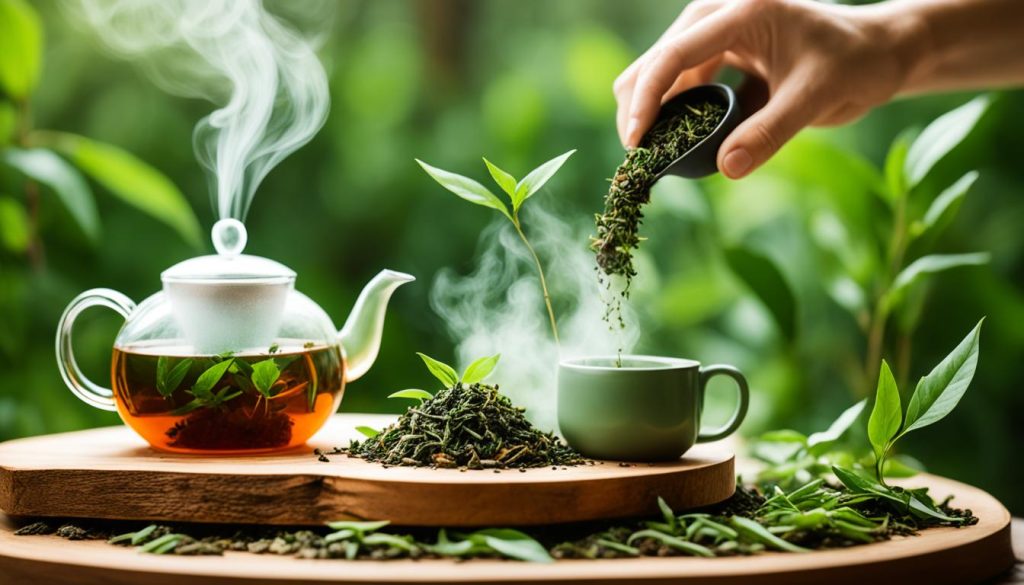
Sustainable Tea Brands
Several tea brands are big on being sustainable. They care a lot about the world and the people in it. By picking these brands, you can help the earth and ensure tea workers are treated fairly.
Bird & Blend
Bird & Blend loves tea and our planet. This UK company makes sure their teas are friendly to the environment. They pick their tea leaves carefully and add cool flavors, all while keeping the earth in mind.
Teapigs
Teapigs also stands for eco-friendly, natural teas. They make sure you know where your tea comes from. Their teas come in biodegradable tea temples and recyclable packaging. This means less waste for the planet.
Hampstead Organic
Hampstead Organic is all about teas that are tasty and good for the earth. It’s a UK brand that has won prizes for its great taste. They go the extra mile to be good to the environment and help tea-growing families.
Enjoying tea from Bird & Blend, Teapigs, or Hampstead Organic is more than a delicious choice. It helps the earth and the people who make the tea. This way, your simple cup of tea does a lot of good.
Embracing a Greener Tea Lifestyle
Ready to go green with your tea habit? Making eco-friendly choices matters a lot. It helps the planet stay healthy and makes sure tea workers are treated well. Below are simple tips and answers to your questions. They’ll guide you in living a more eco-friendly tea life.
1. How can I choose sustainable tea products?
Choosing green teas means going for organic and Fair Trade teas. Organic teas are kind to the Earth as they’re grown without chemicals. Fair Trade means tea workers are fairly paid and work in safe places.
2. What should I consider in terms of packaging?
When picking teas, look for those that come in eco-friendly packages. These could be recyclable or can be composted. Buying tea in loose form and in bulk also cuts down on waste.
3. How can I reduce waste when brewing tea?
Compost used tea leaves or pick biodegradable tea bags. This helps keep waste low. Brewing teas multiple times from the same leaves also cuts down on what gets thrown away after one use.
4. Which tea sets are eco-friendly?
Go for tea sets made from glass or bamboo. They’re strong and good for the environment. Avoid tea pots with plastic parts as they’re bad for the Earth.
| Tea Set | Material |
|---|---|
| Turkish Teapot (Caydanlik) | Stainless Steel |
| East Asian Teapot (Tetsubin) | Cast Iron |
These tea sets include the Turkish teapot known for strong tea. The East Asian teapot keeps tea warm for a long time. Choosing these sets means enjoying tea in an eco-friendly way.
5. Can I use reusable travel cups or mugs?
Definitely! Using a reusable cup or mug is great for the environment. Go for cups made from materials like stainless steel or bamboo.
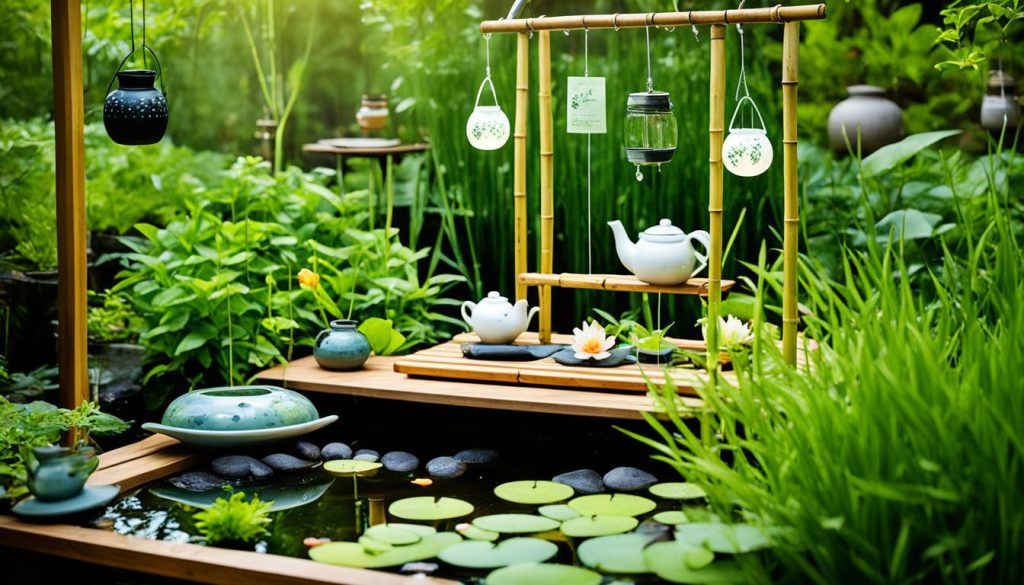
Adding these ideas to your tea routine can have a big impact. Pick sustainable teas and tea sets. Reduce waste, and choose green travel cups. Every small step helps protect the world and supports fair tea making.
Conclusion
Sustainable tea drinking is both tasty and good for the planet. By choosing organic and Fair Trade teas, using eco-friendly tea sets, and sustainable brewing, you help our world. You also support fair and earth-friendly practices in the tea industry.
You should know that not all tea is made the same. Some ways of making tea hurt the earth and people. Choosing sustainable teas gives tea workers fair wages and safe work. It also helps the environment thrive.
Let’s be part of something positive with our tea habits. Making green choices in our tea drinking supports the environment and fair treatment for tea workers. This way, we enjoy tea knowing we help create a better, more ethical world.
